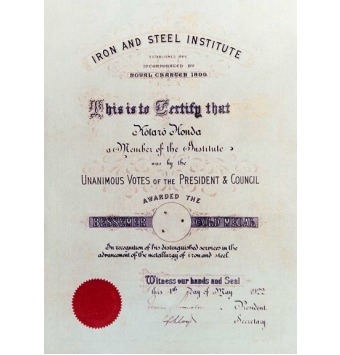KS Steel
 Kotaro Honda was awarded the 1922 Bessemer Gold Medal for his services to the steel industry.
Kotaro Honda was awarded the 1922 Bessemer Gold Medal for his services to the steel industry.
Important inventions often arise in response to the sudden need for novel solutions to new problems. In the years after the outbreak of World War I, Japan faced one such problem in coping with painful restrictions on imports of materials from foreign countries such as Germany. The ensuing resource shortages forced Japan to develop high quality steel and other metal materials on its own. Physicist Kotaro Honda, who opened his RIKEN-Honda Laboratory at Tohoku Imperial University in 1922, was motivated in his metallurgic study of alloys by this need for new directions in domestic steel production.
Honda's research resulted in his invention of KS Steel in 1917, a permanent magnetic steel with three times the magnetic resistance of tungsten steel. Kichizaemon Sumitomo, the head of the family-run conglomerate whose initials appear in its name, provided financial support for the research leading to the invention. Japan's position at the forefront of world research on magnets may largely be attributed to the early work of Honda's research team on KS Steel. His subsequent invention in 1933 of NKS steel, made up of iron, aluminum, nickel, cobalt, copper and titanium whose magnetic resistance is several times higher than that of the initial KS steel, brought him further prestige within Japan.
At the RIKEN-Honda Laboratory at Tohoku Imperial University, Honda also mentored many world-famous scholars and scientists, such as Shoji Nishikawa, Hakaru Masumoto and Seiji Kaya.
